1 本文背景
自 1997 年 9 月 18 日 Ross Ihaka 在 Apache Subversion(下面简称 SVN) 上提交第一次代码以来,R 语言的开发一直由 R Core Team(即 R 语言核心团队)在 SVN 上进行着,到如今 25 年快过去了。25 年,四分之一个世纪,Brian Ripley 大人一路陪伴 R 语言的成长,如今,70 岁了,还在继续!
本文将分析 Brian Ripley 在 SVN 上留下的一段足迹,观察陪跑的一段历程 — 2003 至 2012 的十年,也正是 R 语言蓬勃发展的十年。R 语言开发者网站 (https://developer.r-project.org/) 提供了一份逐年的代码提交日志,官网除了提供日志数据直接下载地址,也提供了日志数据的生成过程,简单来说,就是从代码版本管理工具 SVN 中抽出来,下面的代码可以查看最近两天的提交日志。
## 笔者在 MacOS 上请测可用
svn log -v -r HEAD:\{`date +%Y-%m-%d`\} https://svn.r-project.org/R本文将完全基于 R 语言实现日志数据的分析过程,且保证代码稳定可重复。数据预处理的步骤有:读取文本数据,借助正则表达式匹配、筛选、抽取。仅说明每段代码的作用,而略去单个函数的介绍。分析过程中主要涉及的工具有:Base R 数据操作,lattice [1] 数据可视化,期间穿插笔者的一些分析,希望对读者有所启发。
2 数据准备
目前,R 语言源码及开发一直都在 SVN 上,在 Github 上有一份源码镜像,保持持续同步,R 语言官方网站及博客源码数据存放在 Github (https://github.com/r-devel/r-dev-web)。
2003-2012 年的日志数据是现成的,总计约 10 年的 SVN 提交日志数据,先从 R 语言官网下载,保存到本地文件夹 data-raw/,然后批量导入数据到 R 环境。读者可先查看其中一个文件的数据,直观了解数据的形态,分析探索之旅将从这里出发。
2.1 查看数据
查看纯文本文件 R_svnlog_2003 的头 10 行记录,即 2003 年 CRAN 团队代码提交日志数据。
## 命令行窗口中查看文件前 10 行数据
head -n 10 data-raw/R_svnlog_2003------------------------------------------------------------------------
r27839 | pd | 2003-12-31 18:35:40 -0500 (Wed, 31 Dec 2003) | 2 lines
Changed paths:
M /trunk/BUGS
auto-update
------------------------------------------------------------------------
r27838 | pd | 2003-12-31 18:35:35 -0500 (Wed, 31 Dec 2003) | 2 lines
Changed paths:# 批量导入原始数据到 R 环境
meta_data <- unlist(lapply(
list.files(
path = "data-raw",
full.names = T,
pattern = "R_svnlog_\\d{4}"
), readLines
))查看导入 R 环境中的数据情况
writeLines(meta_data[1:15]) ------------------------------------------------------------------------
r27839 | pd | 2003-12-31 18:35:40 -0500 (Wed, 31 Dec 2003) | 2 lines
Changed paths:
M /trunk/BUGS
auto-update
------------------------------------------------------------------------
r27838 | pd | 2003-12-31 18:35:35 -0500 (Wed, 31 Dec 2003) | 2 lines
Changed paths:
M /branches/R-1-8-patches/BUGS
auto-update
------------------------------------------------------------------------2.2 筛选数据
不难看出,每一条 SVN 提交日志用虚线分割,本文主要关注:
## 提交代码的 ID commit_id、贡献者 contributor、时间戳 timestamp 和修改行数 lines
r27838 | pd | 2003-12-31 18:35:35 -0500 (Wed, 31 Dec 2003) | 2 lines按照时间戳的格式过滤出提交日志的信息,比如 2003-12-31 18:35:35。
## 过滤出想要的文本
filter_meta_data <- meta_data[grepl(pattern = "(\\d{4}-\\d{2}-\\d{2} \\d{2}:\\d{2}:\\d{2})", x = meta_data)]它们是用竖线分割的文本数据,只需将字符串按此规律分割,即可提取各个字段。
## 分割文本
split_meta_data <- strsplit(x = filter_meta_data, split = " | ", fixed = T)接下来整理成适合进行数据操作的数据类型。
## 构造 matrix 类型
tidy_meta_data <- matrix(
data = unlist(split_meta_data), ncol = 4, byrow = T,
dimnames = list(c(), c("commit_id", "contributor", "timestamp", "lines"))
)
## 转化为 data.frame
tidy_meta_data <- as.data.frame(tidy_meta_data)2.3 抽取数据
为了提取文本数据中的有效信息,先准备一个提取函数。
## 从一段文本中,按照给定的匹配模式提取一部分文本
str_extract <- function(text, pattern, ...) regmatches(text, regexpr(pattern, text, ...))提取代码提交时间和修改代码行数。
# 提取时间戳和代码修改行数
spread_meta_data <- within(tidy_meta_data, {
time <- str_extract(text = timestamp, pattern = "\\d{4}-\\d{2}-\\d{2} \\d{2}:\\d{2}:\\d{2}")
cnt <- str_extract(text = lines, pattern = "\\d{1}")
})2.4 数据转换
再进行一些必要的数据转化,提取时间信息
# 代码行数转为整型
spread_meta_data$cnt <- as.integer(spread_meta_data$cnt)
# 时间戳用 POSIXlt 类型表示
spread_meta_data$time <- as.POSIXlt(spread_meta_data$time, format = "%Y-%m-%d %H:%M:%S", tz = "UTC")
# 提取日期
spread_meta_data$date <- format(spread_meta_data$time, format = "%Y-%m-%d", tz = "UTC")
# 提取年份
spread_meta_data$year <- format(spread_meta_data$time, format = "%Y", tz = "UTC")
# 提取月份
spread_meta_data$month <- format(spread_meta_data$time, format = "%m", tz = "UTC")
# 提取时段
spread_meta_data$hour <- format(spread_meta_data$time, format = "%H", tz = "UTC")
# 时段转为整型
spread_meta_data$hour <- as.integer(spread_meta_data$hour)
# 一周的周几
spread_meta_data$weekday <- weekdays(spread_meta_data$time, abbreviate = T)
# 转为 factor 类型
spread_meta_data$weekday <- factor(spread_meta_data$weekday,
levels = c("Mon", "Tue", "Wed", "Thu", "Fri", "Sat", "Sun")
)
# 一年的第几天
spread_meta_data$days <- format(spread_meta_data$time, format = "%j", tz = "UTC")
# 转为整型,一年总共 300 多天,整型够用
spread_meta_data$days <- as.integer(spread_meta_data$days)查看整理后的数据,如下:
# 数据类型
str(spread_meta_data)## 'data.frame': 38954 obs. of 12 variables:
## $ commit_id : chr "r27839" "r27838" "r27837" "r27836" ...
## $ contributor: chr "pd" "pd" "ripley" "jmc" ...
## $ timestamp : chr "2003-12-31 18:35:40 -0500 (Wed, 31 Dec 2003)" "2003-12-31 18:35:35 -0500 (Wed, 31 Dec 2003)" "2003-12-31 12:58:22 -0500 (Wed, 31 Dec 2003)" "2003-12-31 11:22:43 -0500 (Wed, 31 Dec 2003)" ...
## $ lines : chr "2 lines" "2 lines" "2 lines" "2 lines" ...
## $ cnt : int 2 2 2 2 4 2 2 2 2 3 ...
## $ time : POSIXlt, format: "2003-12-31 18:35:40" "2003-12-31 18:35:35" ...
## $ date : chr "2003-12-31" "2003-12-31" "2003-12-31" "2003-12-31" ...
## $ year : chr "2003" "2003" "2003" "2003" ...
## $ month : chr "12" "12" "12" "12" ...
## $ hour : int 18 18 12 11 11 11 11 6 6 5 ...
## $ weekday : Factor w/ 7 levels "Mon","Tue","Wed",..: 3 3 3 3 3 3 3 3 3 3 ...
## $ days : int 365 365 365 365 365 365 365 365 365 365 ...# 前几行数据记录
head(spread_meta_data)## commit_id contributor timestamp lines
## 1 r27839 pd 2003-12-31 18:35:40 -0500 (Wed, 31 Dec 2003) 2 lines
## 2 r27838 pd 2003-12-31 18:35:35 -0500 (Wed, 31 Dec 2003) 2 lines
## 3 r27837 ripley 2003-12-31 12:58:22 -0500 (Wed, 31 Dec 2003) 2 lines
## 4 r27836 jmc 2003-12-31 11:22:43 -0500 (Wed, 31 Dec 2003) 2 lines
## 5 r27835 jmc 2003-12-31 11:22:13 -0500 (Wed, 31 Dec 2003) 4 lines
## 6 r27834 jmc 2003-12-31 11:20:09 -0500 (Wed, 31 Dec 2003) 2 lines
## cnt time date year month hour weekday days
## 1 2 2003-12-31 18:35:40 2003-12-31 2003 12 18 Wed 365
## 2 2 2003-12-31 18:35:35 2003-12-31 2003 12 18 Wed 365
## 3 2 2003-12-31 12:58:22 2003-12-31 2003 12 12 Wed 365
## 4 2 2003-12-31 11:22:43 2003-12-31 2003 12 11 Wed 365
## 5 4 2003-12-31 11:22:13 2003-12-31 2003 12 11 Wed 365
## 6 2 2003-12-31 11:20:09 2003-12-31 2003 12 11 Wed 3652.5 保存数据
清理完成后,将数据保存起来,以备后用。
## CRAN 团队 SVN 提交日志数据
saveRDS(spread_meta_data, file = "data/cran-svn-log.rds")3 数据分析
3.1 CRAN 团队
3.1.1 提交量排序(成员)
笔者已迫不及待地想看下这 10 年 R 语言核心团队各个贡献者提交代码的总量,这可以用分组计数实现。
## 按贡献者分组统计提交次数
aggr_meta <- aggregate(x = commit_id ~ contributor, data = spread_meta_data, FUN = function(x) length(unique(x)))下面简单排个序:
## 按提交次数降序排列
aggr_meta[order(aggr_meta$commit_id, decreasing = T), ]## contributor commit_id
## 21 ripley 23728
## 14 maechler 3682
## 7 hornik 3677
## 16 murdoch 2026
## 18 pd 1791
## 2 apache 658
## 10 jmc 609
## 13 luke 582
## 24 urbaneks 420
## 8 iacus 382
## 17 murrell 335
## 11 leisch 284
## 23 tlumley 153
## 20 rgentlem 141
## 22 root 87
## 5 duncan 82
## 3 bates 76
## 1 (no author) 61
## 6 falcon 45
## 4 deepayan 41
## 19 plummer 28
## 12 ligges 26
## 15 martyn 20
## 9 ihaka 14Ripley 大人的提交量远超其他贡献者,是绝对的主力呀!对于我这个之前不太了解核心团队的人,这是令人感到惊讶的。尽管我之前已经听说过一点 Ripley 大人的传说,他是核心成员,拥有很大话语权,对 CRAN 上发布的 R 包「喊打喊杀」,其实,正因 Ripley 大人对质量的把控,才早就了 R 语言社区的持续发展。
library(lattice)
barchart(
data = aggr_meta, reorder(contributor, commit_id) ~ commit_id, origin = 0,
horiz = T, xlab = "提交量", ylab = "R Core Team",
col = "lightblue", border = NA, scales = "free",
panel = function(...) {
panel.grid(h = 0, v = -1)
panel.barchart(...)
}
)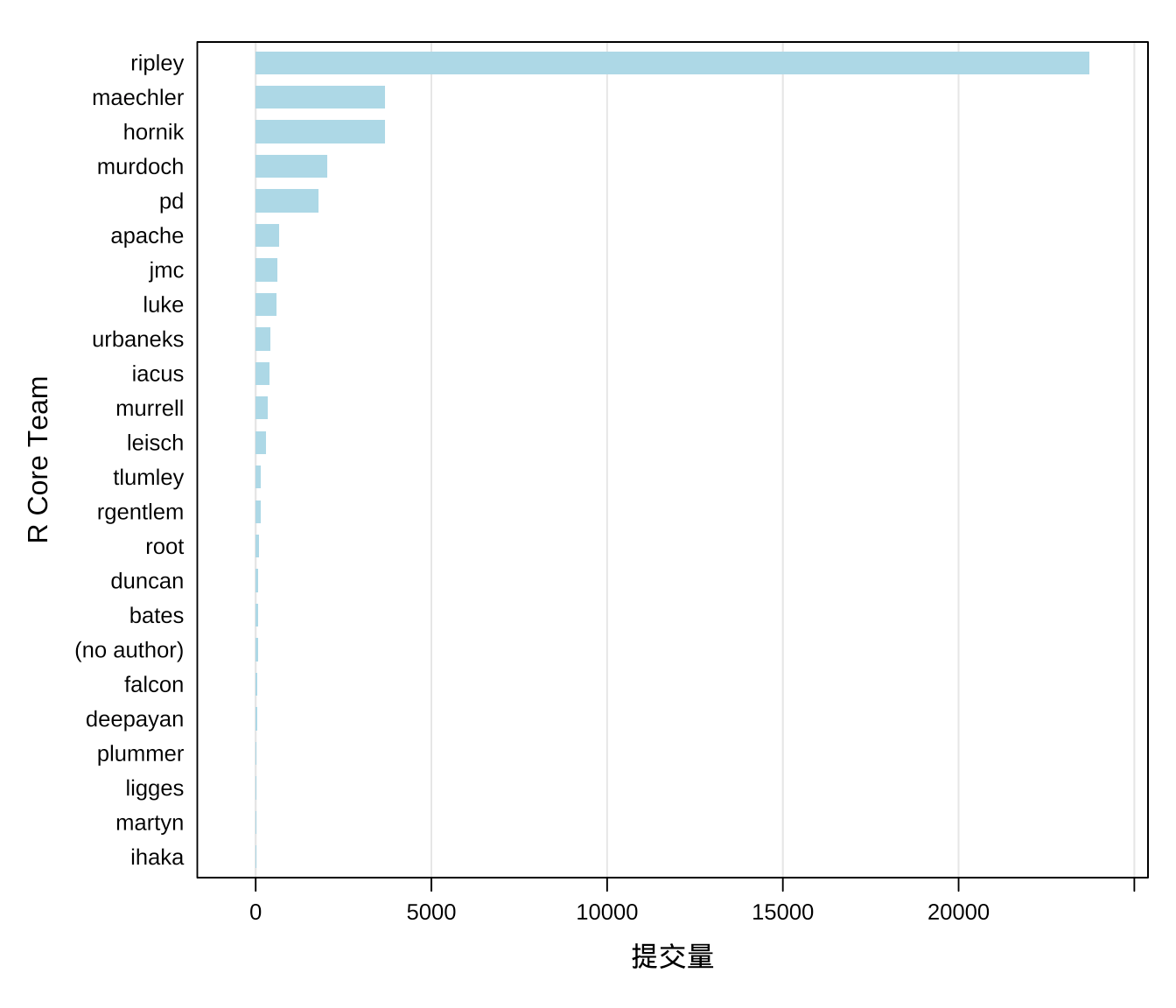
图 3.1: R Core Team 代码提交量的分布
图中 root、(no author) 和 apache 一看就不是正常的人名,请读者忽略。SVN 日志中涉及了部分 R Core Team 成员,笔者将 SVN ID、姓名、主页,整理成表 3.1,方便对号入座,这大都是非常低调的一群人。
- Martyn Plummer 维护 JAGS 以及 rjags 包
- Paul Murrell 维护 grid 包
- Douglas Bates 维护 nlme 包
- Deepayan Sarkar 维护 lattice 包
- ……
他们还在 Bioconductor、R Journal、Use R! 和 Journal of Statistical Software 等组织中做了大量工作。
3.1.2 提交量趋势(星期)
接下里,看看每个贡献者提交量的星期分布。Ripley 大人,不管周末还是不周末都会提交大量代码,只是提交量在周六、周日明显要少一些,毕竟也是要休息的。Hornik 和 Ripley 类似,周六日会休息一下,Maechler 在周日休息,Murdoch 没有明显的休息规律,工作日和周末差不多。
# 按星期分组计数
aggr_meta_week <- aggregate(
x = commit_id ~ contributor + weekday,
data = spread_meta_data, FUN = function(x) length(unique(x))
)
# 条形图
barchart(
data = aggr_meta_week, weekday ~ commit_id | contributor,
subset = !contributor %in% c("root", "apache", "(no author)"),
horiz = T, xlab = "提交次数", ylab = "星期几",
col = "lightblue", border = NA, origin = 0
)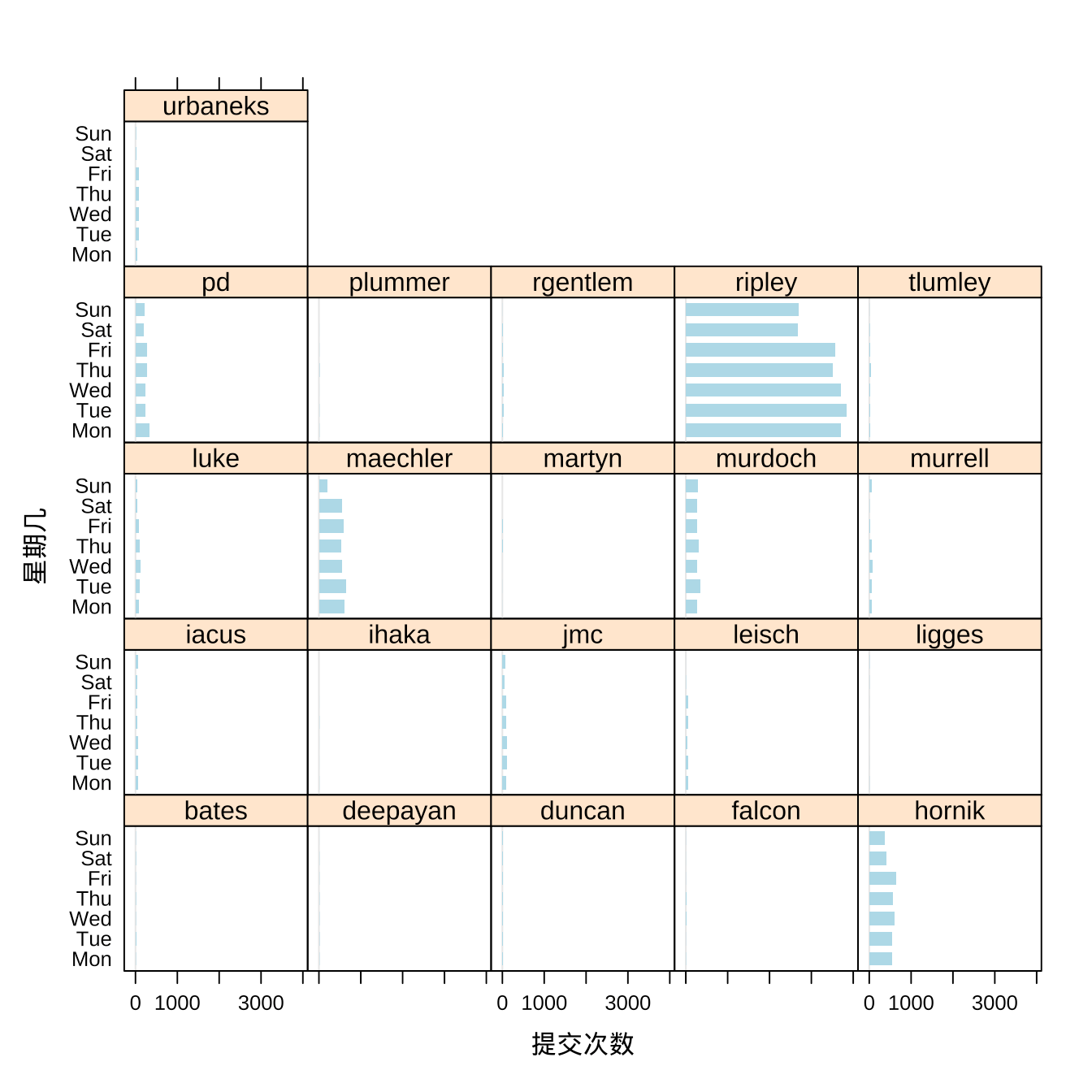
图 3.2: 提交次数的星期分布
接下来看看这 10 年每个贡献者的提交量趋势。
# 分组计数
aggr_meta_ctb_year <- aggregate(
x = commit_id ~ contributor + year,
data = spread_meta_data,
subset = !contributor %in% c("root", "apache", "(no author)"),
FUN = function(x) length(unique(x))
)
# 查看数据
head(aggr_meta_ctb_year)## contributor year commit_id
## 1 pd 2002 1
## 2 bates 2003 37
## 3 duncan 2003 15
## 4 hornik 2003 785
## 5 iacus 2003 205
## 6 ihaka 2003 5xyplot(commit_id ~ as.integer(year) | contributor,
data = aggr_meta_ctb_year,
subset = !contributor %in% c("root", "apache", "(no author)"),
type = "b", xlab = "年份", ylab = "提交量", col = "lightblue", pch = 19
)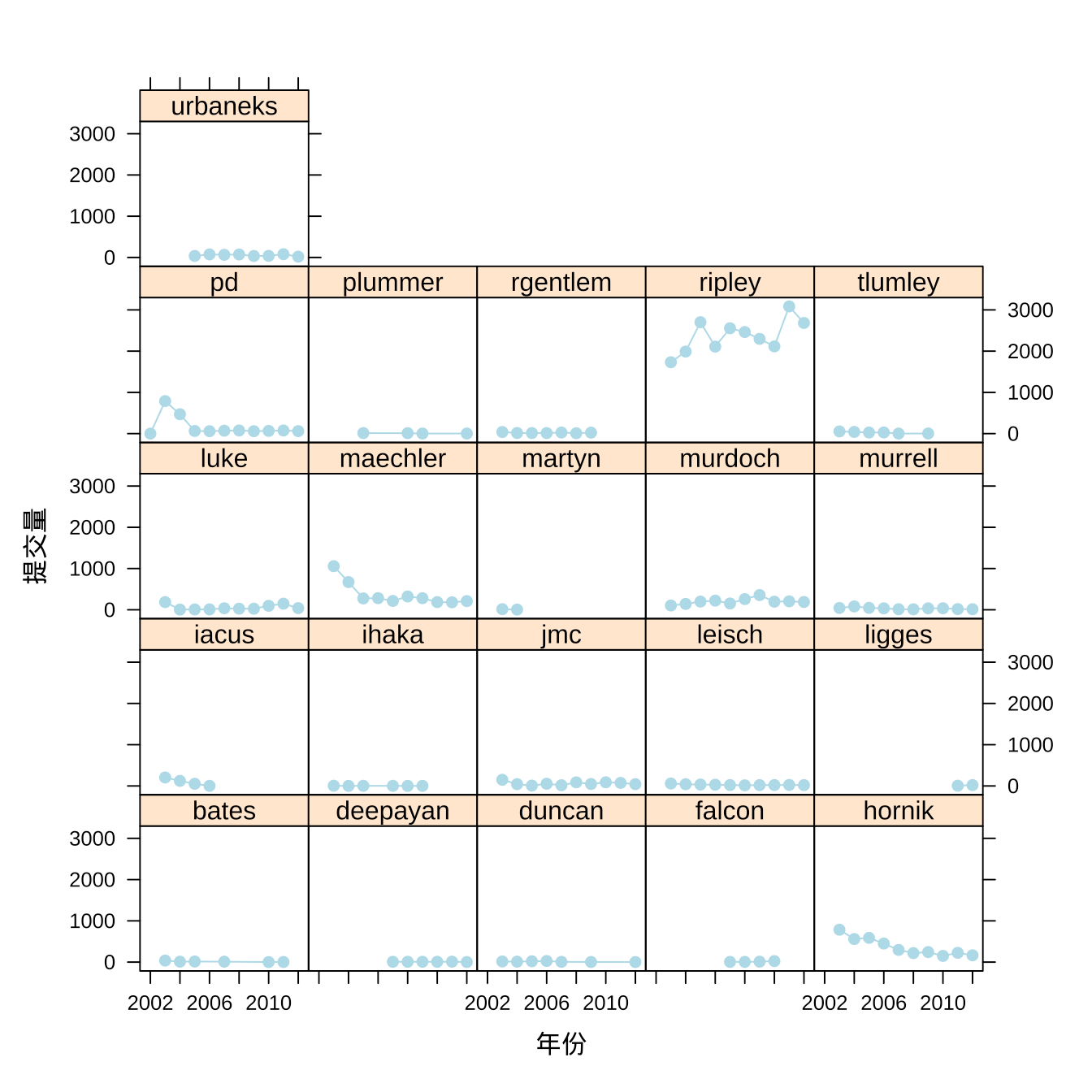
图 3.3: 贡献者年度提交量趋势
原来 R 语言的创始人 Robert Gentleman 和 Ross Ihaka 早就不参与贡献 R Core 代码了。Stefano Iacus、 Martyn Plummer 和 Thomas Lumley 陆续也不活跃了,同时又有 Simon Urbanek、Deepayan Sarkar 和 Uwe Ligges 陆续加入。Ripley 大人在提交量上是如此地遥遥领先,不由得单独进行一波分析。
3.2 Ripley 大人
3.2.1 提交量分布(箱线图)
先按年分组,再按天统计 Ripley 大人的提交量,一年 365 天的提交量分布,如图 3.4 所示。
# 按天聚合提交量,保留天所在年、月信息
aggr_meta_day <- aggregate(
x = commit_id ~ days + month + year, subset = contributor == "ripley",
data = spread_meta_data, FUN = function(x) length(unique(x))
)
# 查看数据
head(aggr_meta_day)## days month year commit_id
## 1 1 01 2003 9
## 2 2 01 2003 10
## 3 3 01 2003 3
## 4 4 01 2003 6
## 5 6 01 2003 2
## 6 8 01 2003 9Ripley 大人有的时候一天提交 30 多次代码,连续 10 年相当稳定地输出。
bwplot(commit_id ~ year,
data = aggr_meta_day,
xlab = "年份", ylab = "提交次数",
par.settings = list(
plot.symbol = list(col = "lightblue"),
box.rectangle = list(col = "lightblue"),
box.dot = list(col = "lightblue"),
box.umbrella = list(col = "lightblue")
)
)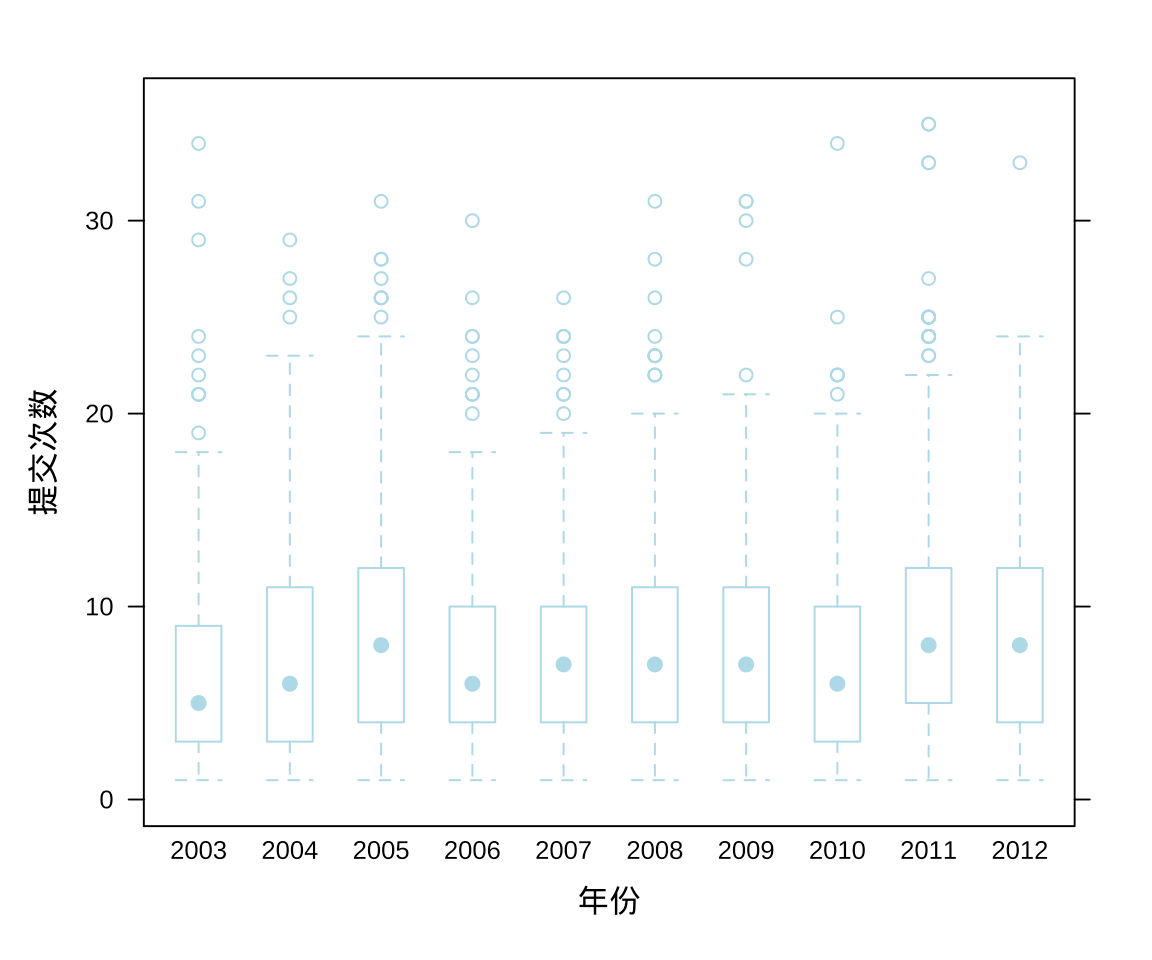
图 3.4: Ripley 大人提交量的分布
3.2.2 提交量分布(提琴图)
相比于葙线图,提琴图可以更加精细地刻画数据的分布,除了 5 个分位点,它用密度估计曲线描述数据的分布。
bwplot(commit_id ~ year,
data = aggr_meta_day,
xlab = "年份", ylab = "提交次数",
col = 'lightblue', border = NA,
panel = panel.violin
)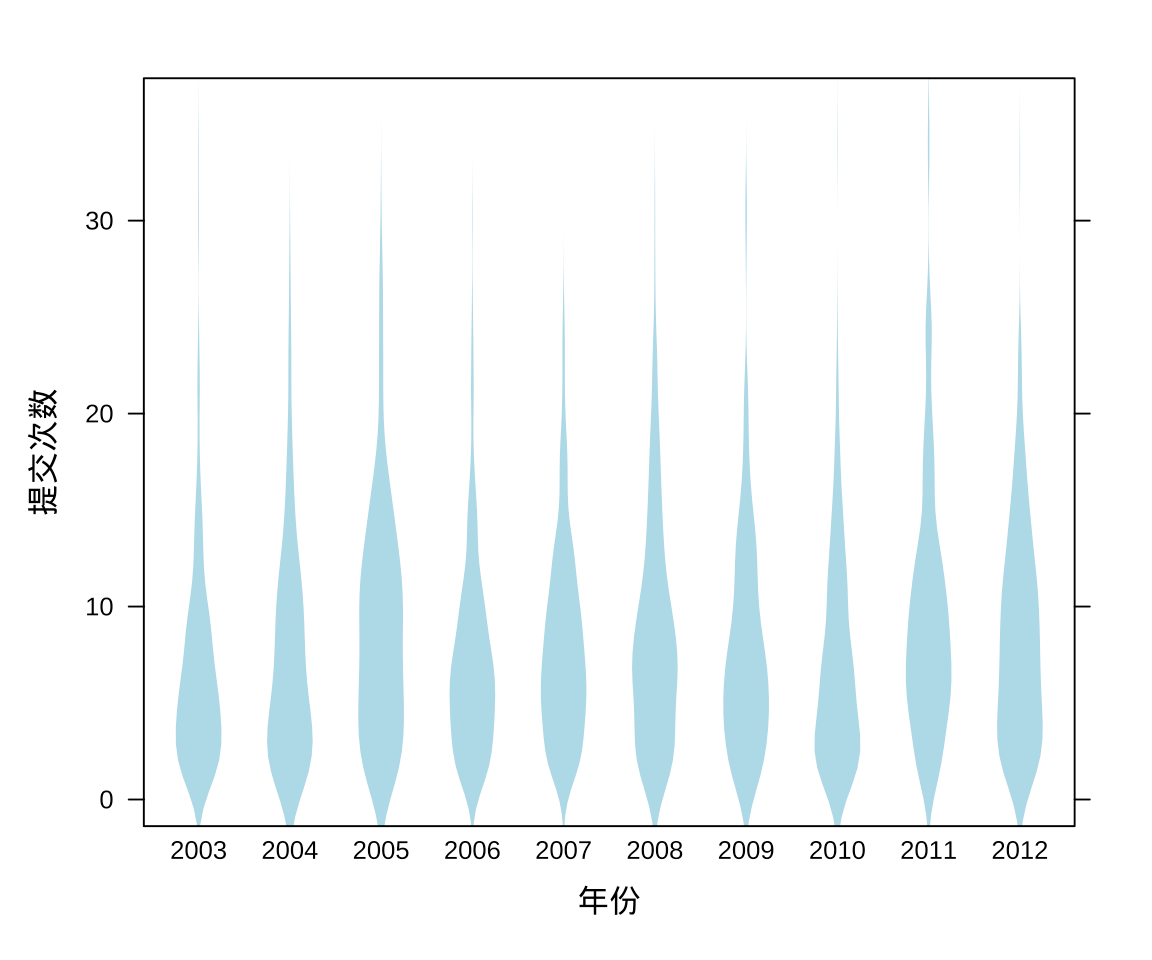
图 3.5: Ripley 大人提交量的分布
3.2.3 提交量分布(密度图)
按年分组,将提交量的分布情况用密度曲线图表示,图中虚线表示提交量的中位数。无论是从提交量的整体分布还是提交量的中位数(可将中位数看作是 Ripley 大人的日平均提交量),Ripley 也是相当稳定地输出呀!
densityplot(~commit_id | year,
data = aggr_meta_day, col = 'lightblue',
panel = function(x, ...) {
panel.densityplot(x, plot.points = FALSE,...)
panel.rug(x, y = rep(0, length(x)), ...)
panel.abline(v = quantile(x, .5), col.line = "lightblue", lty = 2, lwd = 1.5)
},
xlab = "提交次数", ylab = "密度"
)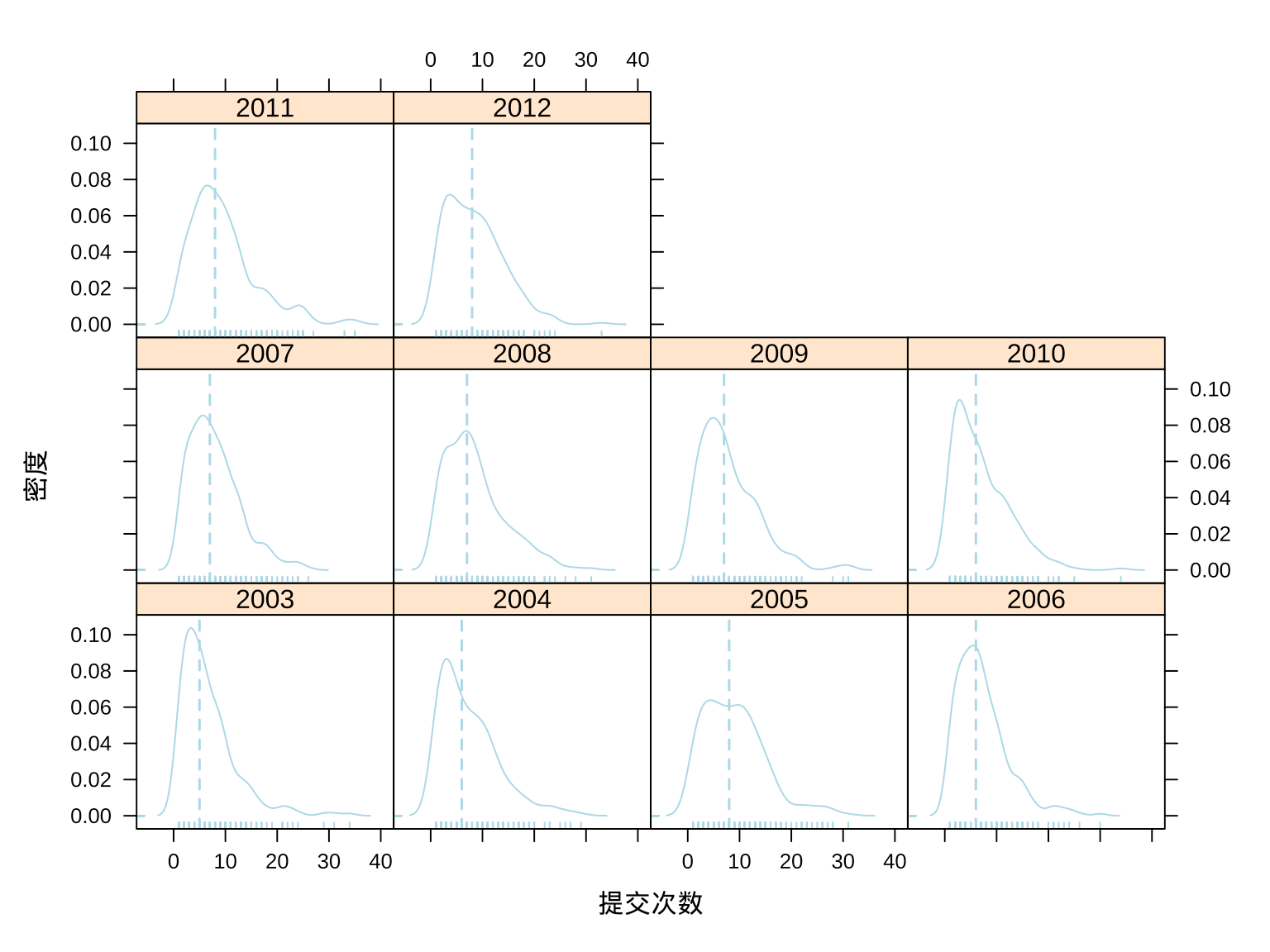
图 3.6: Ripley 大人提交量的分布
3.2.4 提交量趋势(每年)
接下来,看看 Ripley 大人提交量的年度变化趋势。
# 按年统计提交量
aggr_meta_year <- aggregate(
x = commit_id ~ year,
data = aggr_meta_day,
FUN = sum
)
# 查看数据
head(aggr_meta_year)## year commit_id
## 1 2003 1731
## 2 2004 1989
## 3 2005 2701
## 4 2006 2110
## 5 2007 2555
## 6 2008 2463整体上,看起来提交量在逐年稳定地增加。
xyplot(commit_id ~ as.integer(year), data = aggr_meta_year,
type = "b", xlab = "年份", ylab = "提交量", col = 'lightblue', pch = 19
)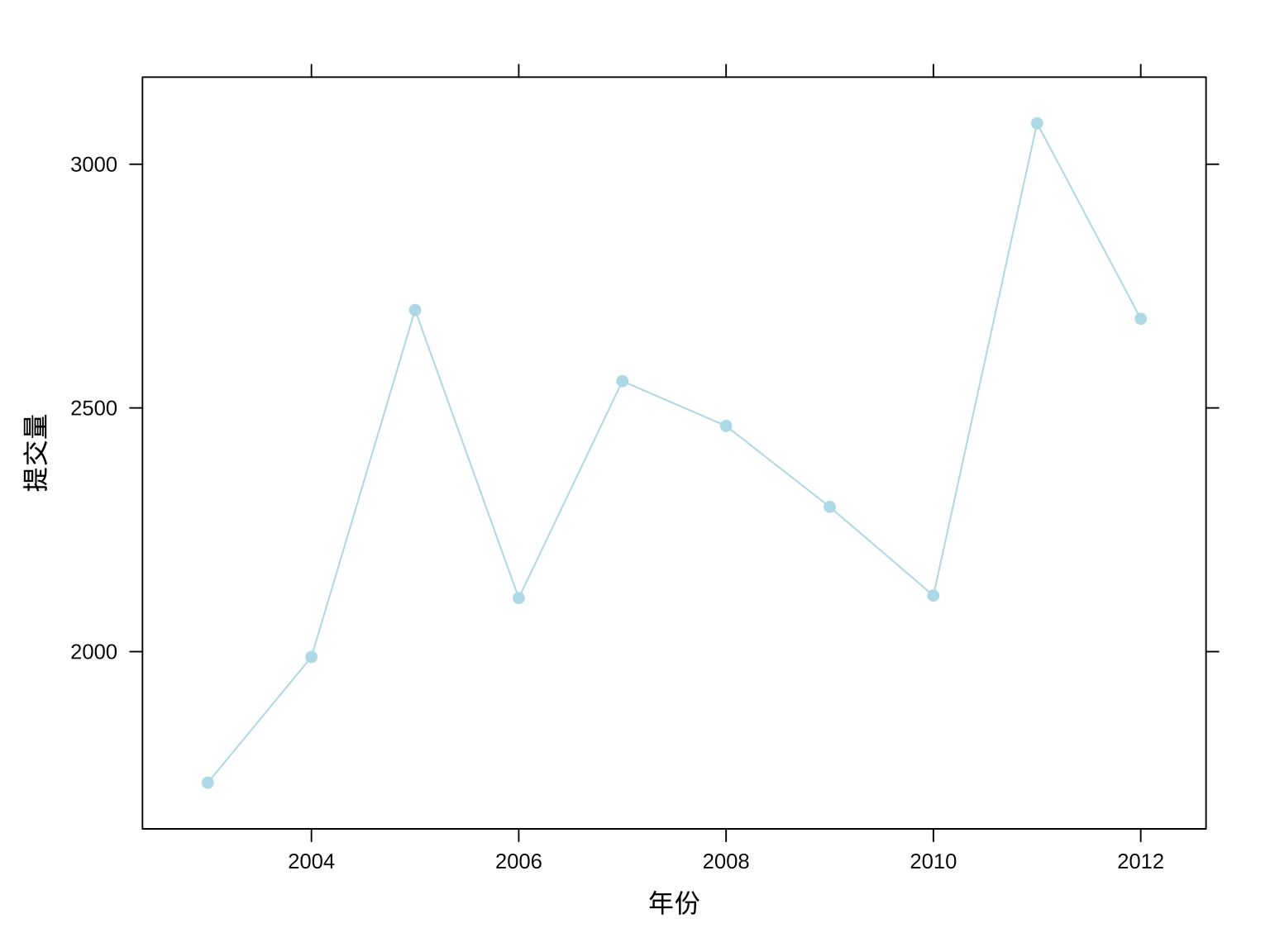
图 3.7: Ripley 大人每年的提交量趋势
3.2.5 提交量趋势(每月)
细分月份来看,Ripley 大人逐年月度提交量趋势。
# 按月统计提交量
aggr_meta_month <- aggregate(
x = commit_id ~ month + year,
data = aggr_meta_day,
FUN = sum
)
# 查看数据
head(aggr_meta_month)## month year commit_id
## 1 01 2003 149
## 2 02 2003 235
## 3 03 2003 152
## 4 04 2003 50
## 5 05 2003 177
## 6 06 2003 177xyplot(commit_id ~ as.integer(month),
groups = factor(year), data = aggr_meta_month,
auto.key = list(columns = 4, space = "top", points = TRUE, lines = TRUE),
type = c("b", "g"), xlab = "月份", ylab = "提交量", scales = "free",
lattice.options = list(
layout.heights = list(
bottom.padding = list(x = -.1, units = "inches")
)
),
par.settings = list(
superpose.line = list(
lwd = 1.5,
col = RColorBrewer::brewer.pal(name = "Set3", n = 10)
),
superpose.symbol = list(
cex = 1, pch = 19,
col = RColorBrewer::brewer.pal(name = "Set3", n = 10)
)
)
)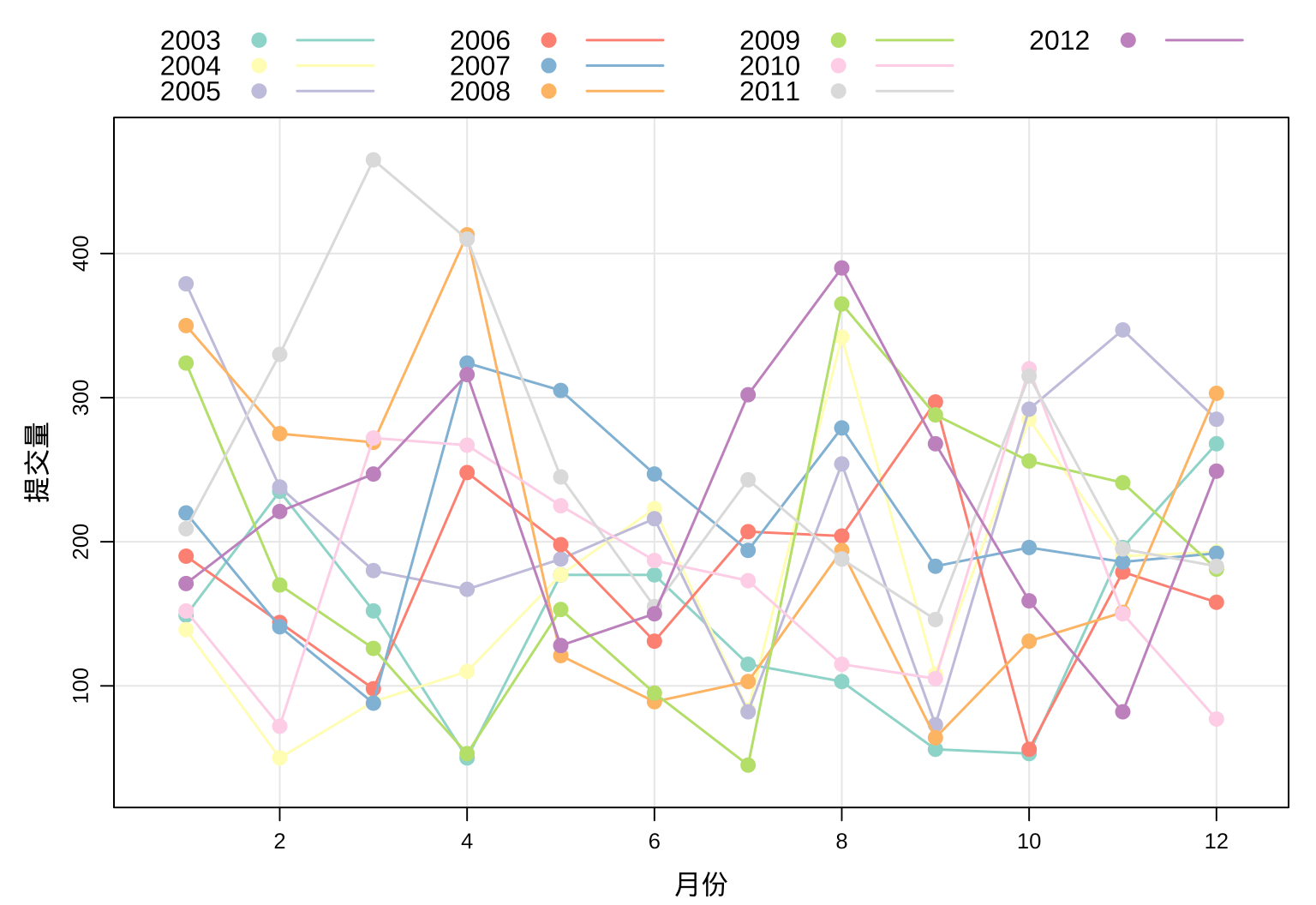
图 3.8: Ripley 大人每月的提交量趋势
看似毫无规律,每年的趋势混合在一起,却正说明 Ripley 大人每年提交代码的量很稳定,很规律。
下面将此数据看作时间序列数据。
aggr_meta_month_ts <- ts(
data = aggr_meta_month$commit_id,
start = c(2003, 1), end = c(2012, 12),
frequency = 12,
class = "ts", names = "commit_id"
)
aggr_meta_month_ts## Jan Feb Mar Apr May Jun Jul Aug Sep Oct Nov Dec
## 2003 149 235 152 50 177 177 115 103 56 53 196 268
## 2004 139 50 89 110 177 223 83 342 108 285 190 193
## 2005 379 238 180 167 188 216 82 254 73 292 347 285
## 2006 190 144 98 248 198 131 207 204 297 56 179 158
## 2007 220 141 88 324 305 247 194 279 183 196 186 192
## 2008 350 275 269 413 121 89 103 194 64 131 151 303
## 2009 324 170 126 53 153 95 45 365 288 256 241 181
## 2010 152 72 272 267 225 187 173 115 105 320 150 77
## 2011 209 330 465 410 245 155 243 188 146 315 195 183
## 2012 171 221 247 316 128 150 302 390 268 159 82 249以时序图观察 Ripley 大人每月的提交量趋势,如图 3.9 所示,是不是看起来很平稳呀?那究竟是不是平稳的时间序列呢?
xyplot(aggr_meta_month_ts)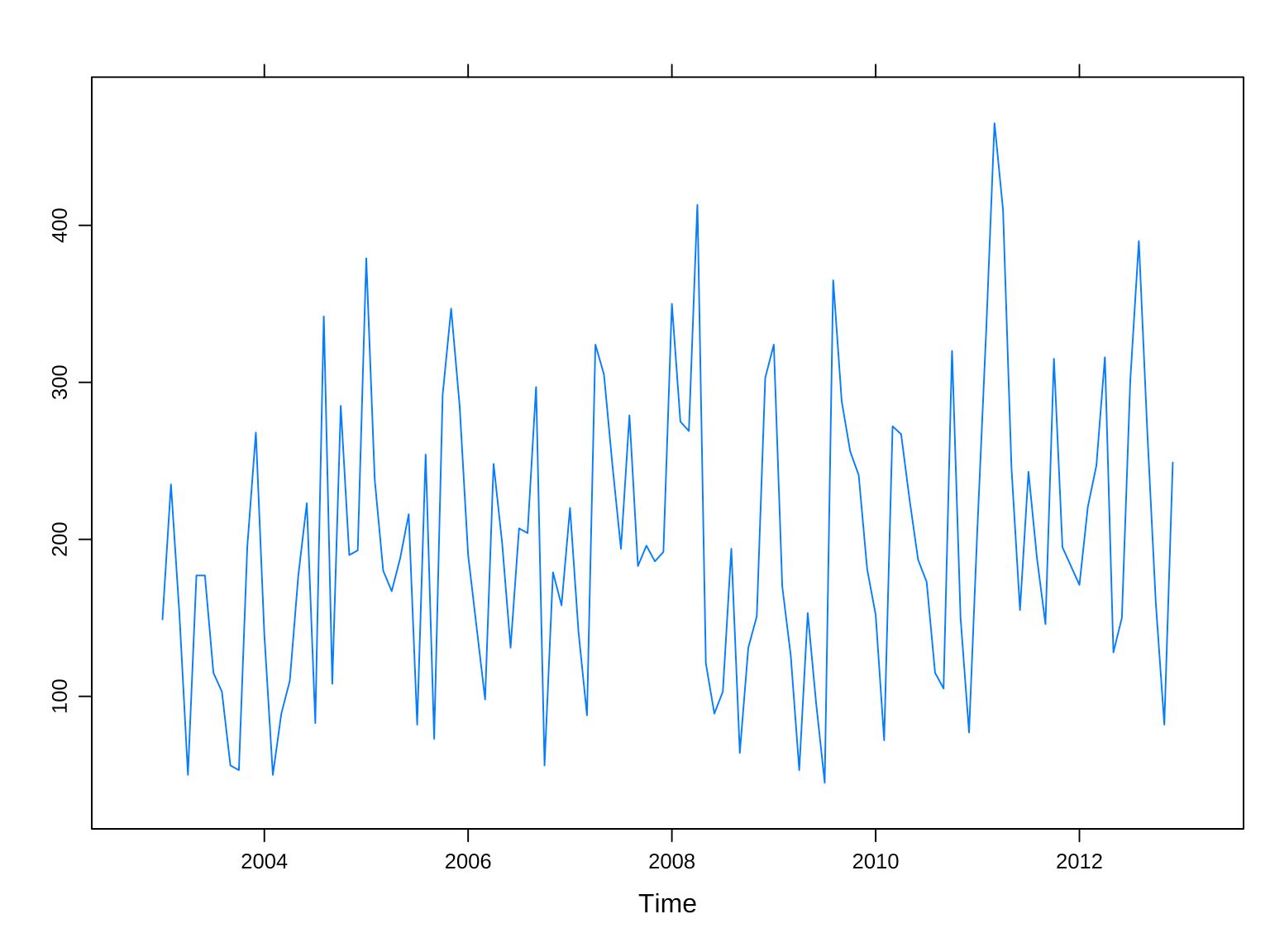
图 3.9: ripley 大人每月的提交量趋势
下面使用 Ljung-Box 检验一下,它的原假设是时间序列是白噪声。
Box.test(aggr_meta_month_ts, lag = 1, type = "Ljung-Box")##
## Box-Ljung test
##
## data: aggr_meta_month_ts
## X-squared = 8, df = 1, p-value = 0.005可见,P 值显著小于 0.05,时间序列不是统计意义上的白噪声,还包含些确定性的信息。
观察时间序列数据中的变化趋势,还可以用水平图,假定 Ripley 大人设定每月提交 100 次代码的 OKR,图 3.10 可以非常直观地看出每年的完成情况。
library(latticeExtra)
# origin 为基线值,后续值相对于它的增减变化
horizonplot(aggr_meta_month_ts,
panel = function(x, ...) {
latticeExtra::panel.horizonplot(x, ...)
grid::grid.text(round(x[1]), x = 0, just = "left")
},
xlab = "", ylab = "",
cut = list(n = 10, overlap = 0), # 10 年
scales = list(draw = FALSE, y = list(relation = "same")),
origin = 100,
colorkey = TRUE, # 右侧梯度颜色条
col.regions = RColorBrewer::brewer.pal(6, "RdBu"),
strip.left = FALSE,
layout = c(1, 10) # 布局 1 列 10 行,每年一行
)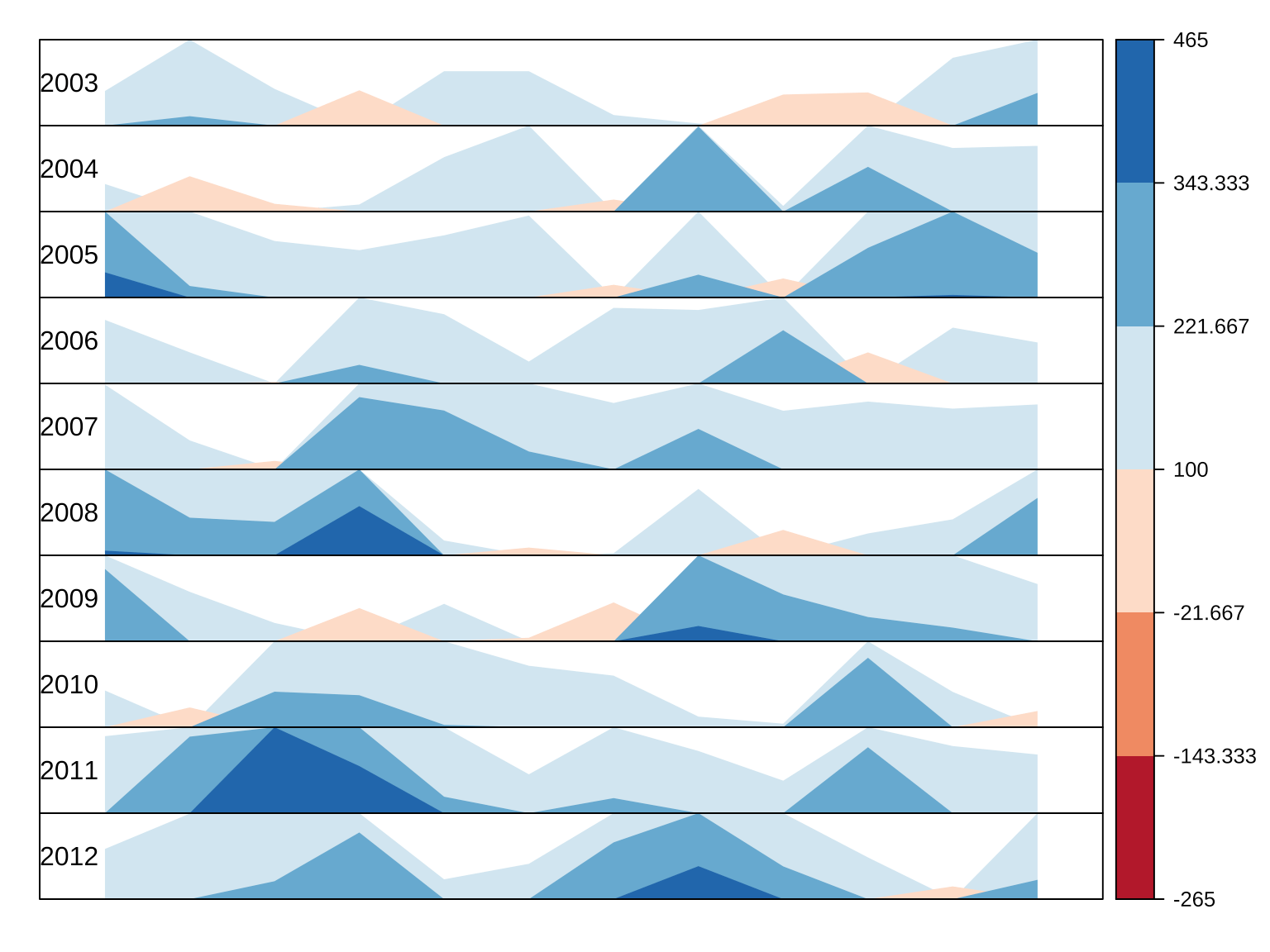
图 3.10: Ripley 大人每月的提交量趋势
3.2.6 提交量趋势(每天)
接下来,再分年按天统计提交量,分组观察趋势变化,如图 3.11 所示。这就很难看出一些规律了,毕竟每天是否写代码,写多少的影响因素太多,Ripley 大人就是再规律,也不至于规律到每天都一样,或者保持某种明显的趋势。
xyplot(commit_id ~ days | year, data = aggr_meta_day,
type = "l", xlab = "天", ylab = "提交量", col = "lightblue")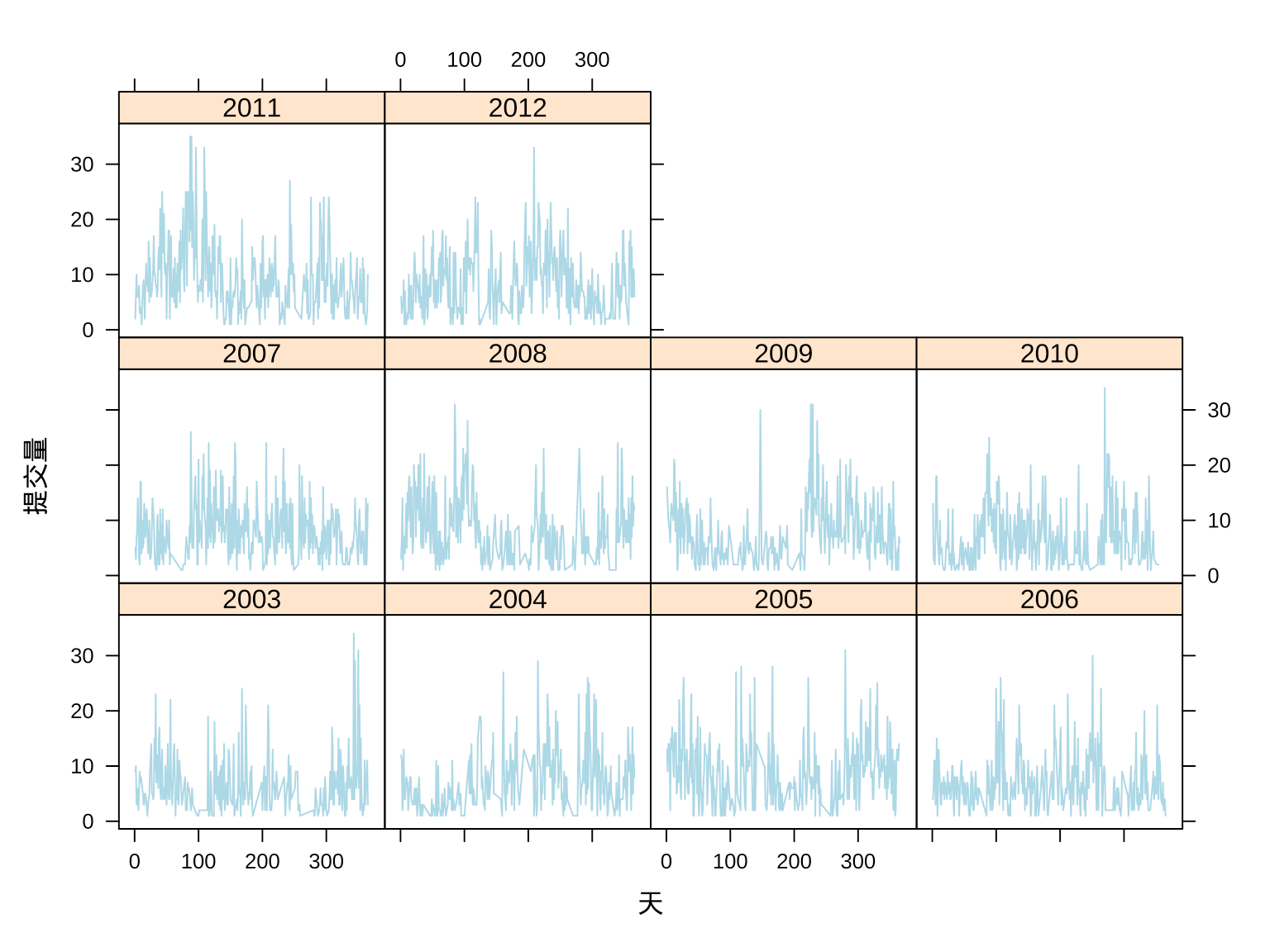
图 3.11: Ripley 大人每天的提交量趋势
3.2.7 提交量趋势(每时)
因此,接下来,按年分组,将每天划分为 24 个时段,再按时段聚合提交量,就可获得年度提交量分时段的分布,如图 3.12 所示。将一年 365 天的数据聚合在一块,这就相当地有规律了,规律体现在每天的作息。
# 按年分组,按小时聚合统计
aggr_meta_hour <- aggregate(
x = commit_id ~ hour + year, subset = contributor == "ripley",
data = spread_meta_data, FUN = function(x) length(unique(x))
)
# 查看数据
head(aggr_meta_hour)## hour year commit_id
## 1 0 2003 13
## 2 1 2003 28
## 3 2 2003 99
## 4 3 2003 186
## 5 4 2003 154
## 6 5 2003 124每天凌晨 2:00 - 5:00 之间为 Ripley 大人提交量的高峰期,Ripley 大人生活在英国,而英国伦敦和中国北京的时差为 7 小时,也就是说图中凌晨 3:00 - 3:59 相当于北京时间上午 10:00 - 10:59。
xyplot(commit_id ~ hour | year, type = "b", data = aggr_meta_hour,
xlab = "时段", ylab = "提交量", col = "lightblue", pch = 19)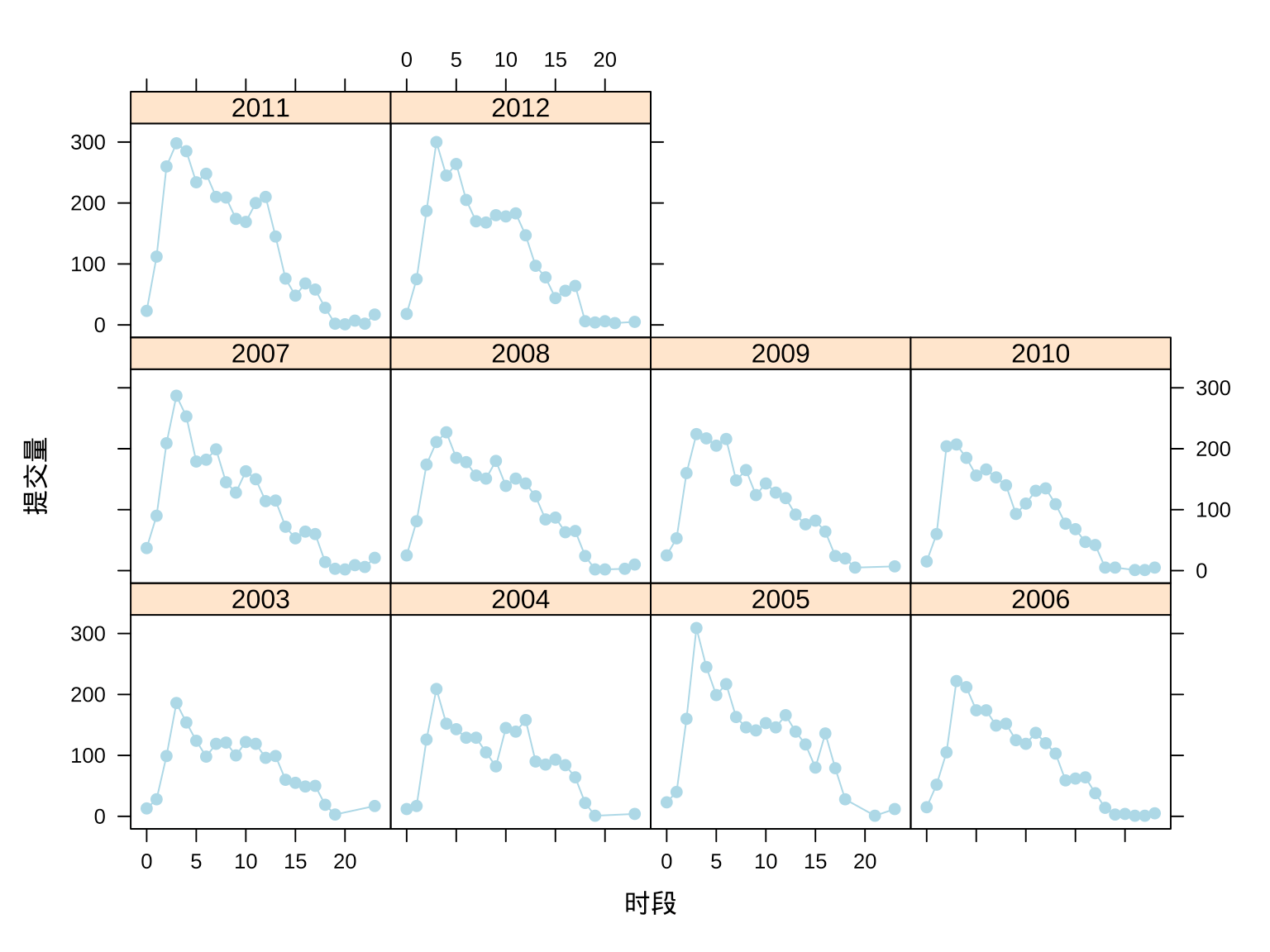
图 3.12: Ripley 大人每小时的提交量趋势
一天 24 小时,Ripley 大人有可能出现在任意一个时段。2005、2007、2011 和 2012 年明显又比其他年份提交量更多些。每年提交代码的高峰时段很稳定,均在北京时间上午 10:00 - 10:59。
4 本文小结
下面从数据探索和数据可视化两个方面谈谈。
有的人何以如此这般的犀利?背后都有一番轻易不为人所知的缘由,唯有拨开云雾才能洞悉其因果。2015 年 Yihui Xie 在《论 R 码农的自我修养》中提及 Brian Ripley 大人曾经和蔼可亲,言外之意,Ripley 大人现在手握利器对 R 包、开发者做减法。我也曾吐槽 R 语言社区开源但没有充分利用开源的力量,更像是长期雇佣了 Ripley 大人做维护和开发。甚至在本文写作之前仍有此类似想法 — 基于 CRAN 团队在 SVN 上提交的 10 年日志数据进行分析,试图回答开源社区是不是谁贡献多谁话语权多?但本文写完,这个问题已不重要,我完全体谅 Ripley 大人,希望出现更多像他这样的维护者。2021 年 Dirk Eddelbuettel 曾有篇文章 An Ode to Stable Interfaces: R and R Core Deserve So Much Praise 致敬 R 的稳定性,本文也有此意,特意避开 ggplot2 和一众净土包,也立下十年可重复之约,感谢 Ripley 大人为开源社区的贡献。
可视化在数据探查、数据探索、数据展示都有非常重要的作用,不同的任务对可视化的要求是不一样的。探查的目的是了解数据质量,探索是为了揭示数据蕴含的规律,而展示是为了交流数据信息、洞见。探查和探索的潜在过程尽管耗时费力,但一般不会给读者直接看到,所以,很多时候,大家更多关注可视化的过程和结果。更多详细介绍,推荐读者看看 Antony Unwin 的文章《Why is Data Visualization Important? What is Important in Data Visualization? 》[2]。
5 环境信息
在 RStudio IDE 内编辑本文的 R Markdown 源文件,用 blogdown 构建网站,Hugo 渲染 knitr 之后的 Markdown 文件,得益于 blogdown 对 R Markdown 格式的支持,图、表和参考文献的交叉引用非常方便,省了不少文字编辑功夫。文中使用了多个 R 包,为方便复现本文内容,下面列出详细的环境信息:
xfun::session_info(packages = c(
"rmarkdown", "blogdown",
"lattice", "latticeExtra", "RColorBrewer"
), dependencies = FALSE)## R version 4.2.1 (2022-06-23)
## Platform: x86_64-apple-darwin17.0 (64-bit)
## Running under: macOS Big Sur ... 10.16
##
## Locale: en_US.UTF-8 / en_US.UTF-8 / en_US.UTF-8 / C / en_US.UTF-8 / en_US.UTF-8
##
## Package version:
## blogdown_1.10 lattice_0.20-45 latticeExtra_0.6-30
## RColorBrewer_1.1-3 rmarkdown_2.14
##
## Pandoc version: 2.18
##
## Hugo version: 0.101.0